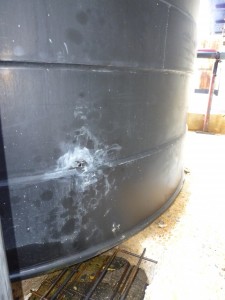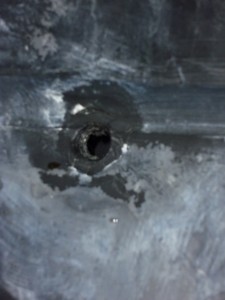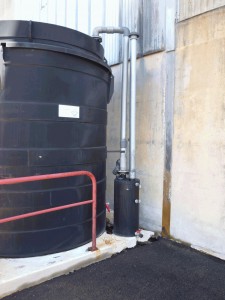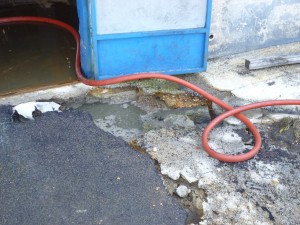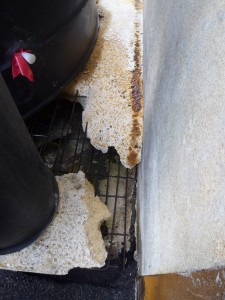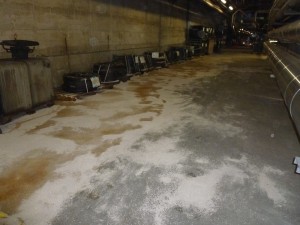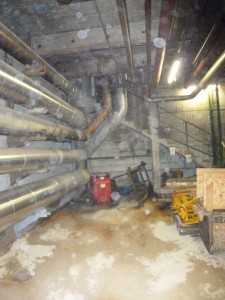A leak occurred in a 10,000-litre, double-walled tanker filled halfway with 33% hydrochloric acid (HCl) used to neutralise the pH of boiler purge water at a tyre factory.
When starting his shift at 6 am, a technician noticed smoke in the vicinity of the HCl storage tank, placed against the boiler room’s outer wall, and detected an acid smell. He informed his supervisor at 6:15. In-house fire-fighters wearing self-breathing apparatuses surveyed the building and the gallery running under the tanker connecting the boiler room to the production building. The factory was idle for its summer down period; only the site’s 120 maintenance firm employees were present. Since the tanker was not installed on a retention system, 2,000 litres of acid flowed into the facility’s sewers and utility ducts. At 6:30 am, a specialist pumped and drained the 3,000 litres of HCl remaining in three 1,000-litre tanks, which lasted until 1:45 pm. The floors beneath the acid spill were washed with extensive amounts of water. The leak was clogged at 7:15 am. The storm drains were only isolated 2 hours after the leak began, i.e. at 8:10 (due to late closure of the drain network plug), thus causing acid to spill into the NOUE ROBERT riverbed. At 9 am, a pH of 6 was measured at the discharge point; an hour later, it had returned to 7. Arriving on-site at 9:20 am, external responders set up a 200-m safety perimeter and spread 2 m³ of sand on the 30-m² pool of acid that had spilled into the underground gallery. The internal emergency plan was activated at 10 am; employees were evacuated 90 min later. First responders left the premises around 4 pm. The Prefecture issued a press release.
The next day, specialist firms removed the fouled sand, pumped water out of the internal drainage network and cleaned the pipelines. An analysis of the various discharge points did not reveal any abnormal acidity, and no impact on fish life was reported. The inspection authorities for classified facilities, notified on the morning of the accident by the factory operator, requested an analysis of both the soil and water table beneath the factory and reopening of the network plug was subject to authority approval.
Before initiating an expert appraisal, the operator felt that the delivery driver had proceeded with tank filling too quickly, causing a pressure surge inside, with the tank not designed to withstand such a surge (unable to evacuate the expansion space). Also, the tank’s poor condition was well known, as a leak had already occurred 2 weeks prior within its double envelope. A replacement was due in September (as part of the procurement schedule).
The tank’s double envelope contained a hole that had been plugged, though the plug used had probably disappeared when the tanker was ripped open. Loss of this plug was responsible for the leak of acid that had remained confined in the double envelope on 13 July.
The operator responded by: contracting a specialist firm to eliminate storm drain water by pumping out the network and to restore the network plug system; collecting all sand spread in the gallery for disposal; and verifying the structural integrity of the pavement. Plans included connecting the pavement where cisterns were stored to the delivery vehicle retention bay, equipped with an underground tank to collect outflow.
The inspection authorities for classified facilities asked the operator to:
- monitor NOUE ROBERTpH on a daily basis (outlet of the storm drain outfall)
- inspect groundwater quality with the site’s piezometers in focusing on pH and suspended solids
- repeat this inspection 1 month hence.
The operator was also required to: commission a certified body to verify the integrity of pipelines in the gallery, determine how best to plug stormwater, and revise the procedure relative to storm drain closure. Other assigned tasks included: submitting a file relative to new tank installation and associated structural works; and ensuring compliance of the transfer area and all storage zones.



